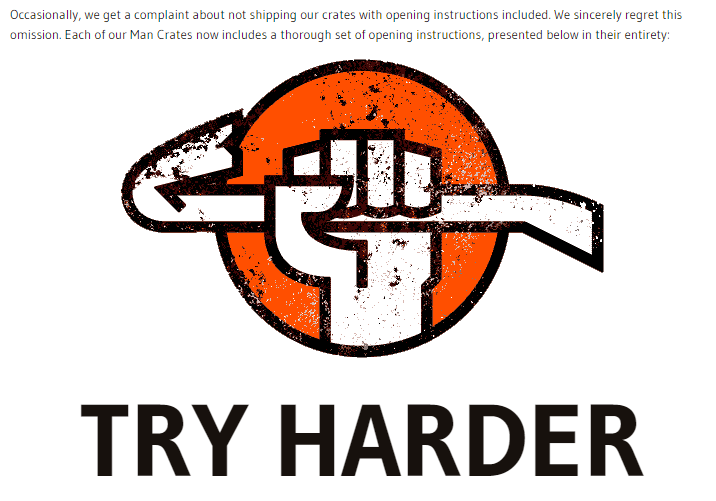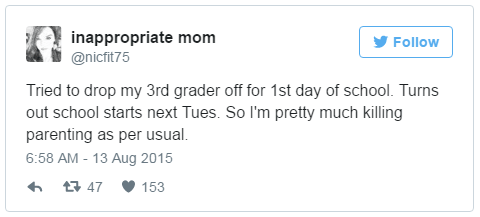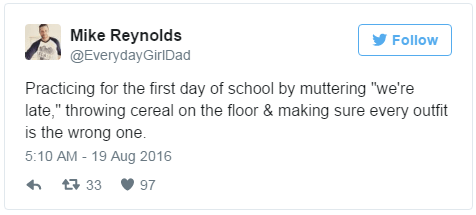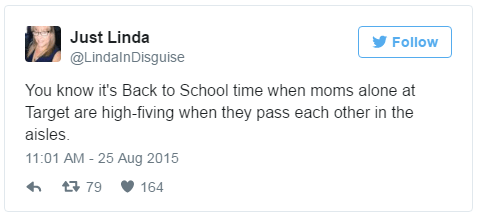Try to picture this: it’s the morning of the first day back to school, the family is around the table having breakfast, and the kids aren’t thrilled about going back. I had to do something to get them excited.
Me, in my best motivational speaker voice: “OK gang! Who’s ready to go back to school?!”
A wave of grunts, mumbling, and complaints rushed over me. It’s all blurry now, but someone might have been crying and I missed it while facepalming.
Well, that didn’t go as I had planned. Not. One. Bit.
School started sometime during these past weeks, and having the kids out the house and back to school is definitely a big mixed bag of emotions. There’s the usual confusion and mix-ups that come with the last days of summer break:
The chaos of getting the kids ready and out the door on time in the morning:
Let’s be honest, the collective sigh of relief after knowing the kids are someone else’s problem, at least during the mornings:
And celebrating those small victories in the aisles of a store:
Marketing your business is not that stressful or chaotic, if you know what you’re doing. At 8 Signal, back to school means going back to basics, so for this week I’ve decided to give you a quick recap of the basics of marketing. Consider this your Marketing 101 course. Don’t worry, we won’t grade you.
There are 5 basic steps to creating a successful marketing campaign:
- Identify your ideal target market so that you can connect with your customers
- Discover your unique selling proposition so that you stand out from the competition
- Focus on describing the benefits
- Create an irresistible offer
- Find the best places to advertise your business
Identifying Your Target Market
 Save money and get a better return on your investment by defining your target market. Look at your current customer base—who are they? Why do they buy from you? Look for the common characteristics and interests that your client base has. Who brings in the most business? It’s very likely that people like them could also benefit from what you have to offer.
Save money and get a better return on your investment by defining your target market. Look at your current customer base—who are they? Why do they buy from you? Look for the common characteristics and interests that your client base has. Who brings in the most business? It’s very likely that people like them could also benefit from what you have to offer.
Check out your competition. Who are their current clients? Who are they targeting? You don’t want to go after the same market as your competition, but you might find something that they have overlooked.
Figure out not only who has a need for your product, but also who is most likely to buy it. Consider the demographics and psychographics of your target: age, location, gender, income level, marital or family status, personality, attitudes, values, interests and hobbies, etc.
Determine how your business fits into your target’s life. How and when will your target use the product? What media does your target turn to for information? Does your ideal customer read the newspaper, use Google, attend certain events?
Once you know who you’ll be targeting, everything else becomes much easier.
Discover Your Unique Selling Proposition
A unique selling proposition will define your company’s unique position in the market. Your selling proposition is an important part of creating a brand that customers truly love. Your potential customers have a lot of options to choose from—they may even have a hard time deciding who deserves their time, money, and trust.
A unique selling proposition helps you help your customers. When you make your proposition obvious, different, and memorable enough, they can see what your business has to offer that no one else has. It sets you apart from your competitors.
Theodore Levitt, Professor at Harvard’s School of Business, said, “Differentiation is one of the most important strategic and tactical activities in which companies must constantly engage.”
When coming up with your selling proposition, begin by asking yourself these questions:
- What could we do that no one else is doing?
- Are there unique ways to package, price, or deliver our products and services?
- How could we create a totally unique and personal customer experience?
- How can I help my customers in a way that is rare and different?
Take a look at Man Crates, an online store that does “awesome gifts for men” and ships them in “sturdy wooden crates sealed firmly with ill intentions” that are to be opened with a crowbar. They sell unique items such as customized beer mugs, grilling equipment, and beef jerky, but that’s not the only unique thing about them. The whole company is just overflowing with personality. See for yourself: just check out their detailed instruction manual on opening their crates, direct from their help page:

Focus on the Benefits
Make sure you’re emphasizing the value from your customer’s perspective. Think of it as the ratio of the perceived benefits to perceived costs. The value proposition includes the whole bundle of benefits your business promises to deliver, not just the functional benefits of the product itself.
Let’s say you have a business that manufactures and sells wooden furniture. Don’t think of a table as a piece of wood. When you start to think about the benefits, you’ll no longer sell “a table,” you’ll be selling a piece of furniture filled with delicious food, a place where a family can sit down, enjoy a meal, and bond.
 Take a look at TOMS, the one for one company. TOMS started as a shoe company that matched every pair of shoes purchased with a new pair of shoes for a child in need. Eventually they grew and started producing sunglasses, bags, and general apparel, but their ideals have stayed the same.
Take a look at TOMS, the one for one company. TOMS started as a shoe company that matched every pair of shoes purchased with a new pair of shoes for a child in need. Eventually they grew and started producing sunglasses, bags, and general apparel, but their ideals have stayed the same.
Why would you want to buy a pair of TOMS shoes? You could buy shoes from any other company, so why would you choose TOMS? Well, besides being very comfortable, TOMS gives you the chance to improve lives and make a difference. For every product you buy, TOMS will help a person in need: “One for One.”
Create an Irresistible Offer
There are 86,400 seconds in a day, and you have 3 to make an exceptional first impression. According to Business Insider, it takes around three seconds for someone to determine whether they like you and want to do business with you. As you can imagine, it’s absolutely necessary that your offer is irresistible and something that your target audience simply can’t refuse.
You have to understand that even if your product is great, your service is stellar, you’re a great guy, everyone loves you, women want you, and men want to be you, your potential customers don’t know that yet. You have to tell them, and, most important, you have to prove it.
In Mark Joyner’s book, The Irresistible Offer: How to Sell Your Product or Service in 3 Seconds or Less, Joyner tells us we have to answer the following questions nearly instantly to connect with a potential client if they are to pay us any attention:
- What are you trying to sell?
- How much is it?
- Why should I believe you?
- What’s in it for me?
Explain what your product or service is, explain how much it costs, remove all worries from your prospects, take away all the risk from the offer. Remember, you have 3 seconds to explain how your product is going to make or save your clients money. To most people, nothing else matters except for what they get from your offer, so your product or service must have a genuinely high return on investment. For more info on creating irresistible offers, read my recent post on Creating Irresistible Offers.
Find the Best Places to Advertise
 Always keep in mind that not all channels (or places to advertise) are created equal, nor are their results. Some of them will turn your audience into brand loyal clients, some of them will just go unnoticed. One channel or tactic might work great for one business, but not for others. So what do you need to know when you’re looking for the best place to advertise?
Always keep in mind that not all channels (or places to advertise) are created equal, nor are their results. Some of them will turn your audience into brand loyal clients, some of them will just go unnoticed. One channel or tactic might work great for one business, but not for others. So what do you need to know when you’re looking for the best place to advertise?
Put yourself in your customer’s shoes: where would you go to look for what you have to offer?
Identifying your target market is closely related to this step. You need to identify the media that most accurately portrays your client base, and the only way you can do this is by defining your target market.
Consider different forms of media when deciding where to advertise. You can advertise in newspapers, radio, TV, magazines, directories, online, or social media—the list is endless and each option allows you to reach your audience at different levels.
Are you already taking these 5 steps to market your business? Let us know how they have worked for you in the comments section below. Give us a call at (915) 585-1919 or fill out our online form to have one of our experts get in touch with you. We are 8 Signal, your marketing department, without the overhead!
Photos courtesy of: Geecy, Richard_of_England, otakuchick.










